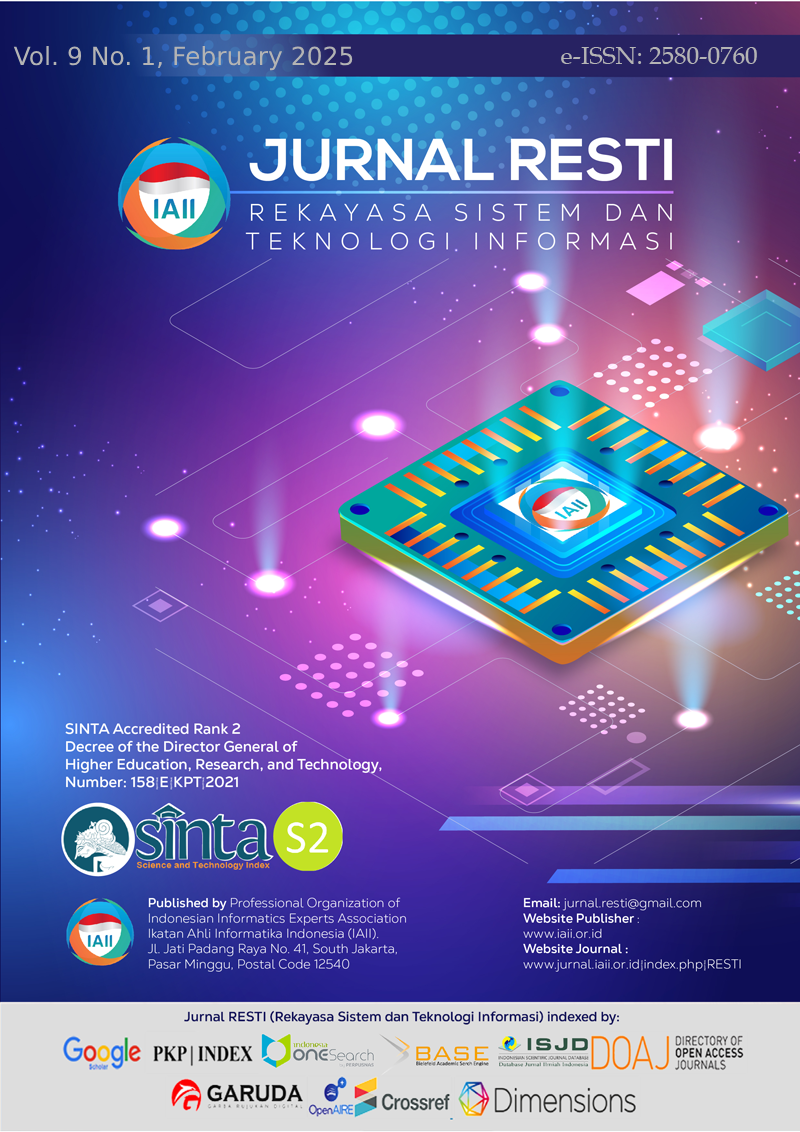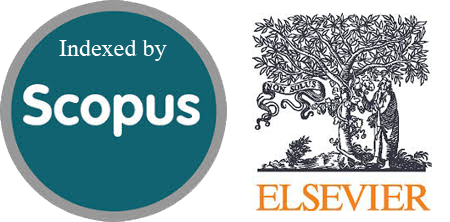Application of VGG16 in Automated Detection of Bone Fractures in X-Ray Images
Abstract
The purpose of this research is to determine whether or not a deep learning model called VGG16 can automatically identify bone fractures in X-ray pictures. The dataset, sourced from Kaggle, includes 10,522 images of human hand and foot bones, which underwent preprocessing steps such as normalization and resizing to 224x224 pixels to enhance data quality. The study utilizes the VGG16 architecture, pre-trained on ImageNet, as a base model, with transfer learning applied to adapt the model for fracture detection by fine-tuning its weights. This architecture consists of five blocks of convolutional and max-pooling layers to effectively extract and enhance information from the images for precise classification. The training and testing phases utilized an 80:20 split of the data, employing binary cross-entropy as the loss function and the Adam optimizer for efficient weight updates. The model achieved high performance, with an accuracy of 99.25%, precision of 98.62%, recall of 98.88%, and an F1-score of 99.16% over 25 epochs with a batch size of 128. Experimental results indicate that smaller batch sizes generally enhance accuracy and reduce loss values, with batch sizes of 128 and 16 yielding optimal performance. The study's findings underscore the potential of VGG16 in improving diagnostic accuracy and reliability in medical imaging, providing a robust tool for fracture detection. Future research should continue exploring hyperparameter optimization to further enhance model performance while balancing computational efficiency.
Downloads
References
S. Rao Karanam, Y. Srinivas, and S. Chakravarty, “A systematic review on approach and analysis of bone fracture classification,” Mater Today Proc, vol. 80, pp. 2557–2562, Jan. 2023, doi: 10.1016/j.matpr.2021.06.408.
J. Iliaens, J. Onsea, H. Hoekstra, S. Nijs, W. E. Peetermans, and W. J. Metsemakers, “Fracture-related infection in long bone fractures: A comprehensive analysis of the economic impact and influence on quality of life,” Injury, vol. 52, no. 11, pp. 3344–3349, Nov. 2021, doi: 10.1016/j.injury.2021.08.023.
D. P. Yadav and S. Rathor, “Bone Fracture Detection and Classification using Deep Learning Approach,” in 2020 International Conference on Power Electronics and IoT Applications in Renewable Energy and its Control, PARC 2020, Institute of Electrical and Electronics Engineers Inc., Feb. 2020, pp. 282–285. doi: 10.1109/PARC49193.2020.236611.
A. Noureen, M. A. Zia, A. Adnan, and M. Hashim, “Analysis and Classification of Bone Fractures Using Machine Learning Techniques,” in E3S Web of Conferences, EDP Sciences, Aug. 2023. doi: 10.1051/e3sconf/202340902015.
K. A. Putri, W. Fawwaz, and A. Maki, “Enhancing Pneumonia Disease Classification using Genetic Algorithm-Tuned DCGANs and VGG-16 Integration,” Open Access Journal, vol. 6, no. 1, pp. 11–22, 2024, doi: 10.35882/jeemi.v6i1.349.
D. Albashish, R. Al-Sayyed, A. Abdullah, M. H. Ryalat, and N. Ahmad Almansour, “Deep CNN Model based on VGG16 for Breast Cancer Classification,” in 2021 International Conference on Information Technology, ICIT 2021 - Proceedings, Institute of Electrical and Electronics Engineers Inc., Jul. 2021, pp. 805–810. doi: 10.1109/ICIT52682.2021.9491631.
D. P. Yadav and G. Sharma, “Human Bone fracture prognosis using Income inequality based Texture Feature and Support Vector Machine,” IOP Conf Ser Mater Sci Eng, vol. 1116, no. 1, p. 012137, Apr. 2021, doi: 10.1088/1757-899x/1116/1/012137.
M. F. Russe et al., “AI-based X-ray fracture analysis of the distal radius: accuracy between representative classification, detection and segmentation deep learning models for clinical practice,” BMJ Open, vol. 14, no. 1, Jan. 2024, doi: 10.1136/bmjopen-2023-076954.
J. Oppenheimer, S. Lüken, B. Hamm, and S. M. Niehues, “A Prospective Approach to Integration of AI Fracture Detection Software in Radiographs into Clinical Workflow,” Life, vol. 13, no. 1, Jan. 2023, doi: 10.3390/life13010223.
Madushani Rodrigo, Mohan Kumar, Abdelaziz Faramawy, and Harsha Arya, “Bone Fracture Multi-Region X-ray Data,” Apr. 2024.
G. J. Chowdary, G. Suganya, M. Premalatha, and S. Ganapathy, “Impact Of Machine Learning Models In Pneumonia Diagnosis With Features Extracted From Chest X-Rays Using VGG16,” 2021.
M. Abdel-Nasser, J. Melendez, A. Moreno, and D. Puig, “The impact of pixel resolution, integration scale, preprocessing, and feature normalization on texture analysis for mass classification in mammograms,” Int J Opt, vol. 2016, 2016, doi: 10.1155/2016/1370259.
G. Murtaza et al., “Deep learning-based breast cancer classification through medical imaging modalities: state of the art and research challenges,” Artif Intell Rev, vol. 53, no. 3, pp. 1655–1720, Mar. 2020, doi: 10.1007/s10462-019-09716-5.
J.-M. Jo, “빅데이터의 정규화 전처리과정이 기계학습의 성능에 미치는 영향 조준모 * Effectiveness of Normalization Pre-Processing of Big Data to the Machine Learning Performance”, doi: 10.13067/JKIECS.2019.14.3.547.
I. Izonin, R. Tkachenko, N. Shakhovska, B. Ilchyshyn, and K. K. Singh, “A Two-Step Data Normalization Approach for Improving Classification Accuracy in the Medical Diagnosis Domain,” Mathematics, vol. 10, no. 11, Jun. 2022, doi: 10.3390/math10111942.
N. ŞENGÖZ, T. YİĞİT, Ö. ÖZMEN, and A. H. ISIK, “Importance of Preprocessing in Histopathology Image Classification Using Deep Convolutional Neural Network,” Advances in Artificial Intelligence Research, vol. 2, no. 1, pp. 1–6, Feb. 2022, doi: 10.54569/aair.1016544.
P. Desai, J. Pujari, C. Sujatha, A. Kamble, and A. Kambli, “Hybrid Approach for Content-Based Image Retrieval using VGG16 Layered Architecture and SVM: An Application of Deep Learning,” SN Comput Sci, vol. 2, no. 3, May 2021, doi: 10.1007/s42979-021-00529-4.
S. Chakrabarti et al., Compressed Residual-VGG16 CNN Model for Big Data Places Image Recognition.
H. J. Jie and P. Wanda, “Runpool: A dynamic pooling layer for convolution neural network,” International Journal of Computational Intelligence Systems, vol. 13, no. 1, pp. 66–76, Jan. 2020, doi: 10.2991/ijcis.d.200120.002.
A. Nasiri, A. Taheri-Garavand, and Y. D. Zhang, “Image-based deep learning automated sorting of date fruit,” Postharvest Biol Technol, vol. 153, pp. 133–141, Jul. 2019, doi: 10.1016/j.postharvbio.2019.04.003.
M. F. Hashmi, S. Katiyar, A. G. Keskar, N. D. Bokde, and Z. W. Geem, “Efficient pneumonia detection in chest xray images using deep transfer learning,” Diagnostics, vol. 10, no. 6, Jun. 2020, doi: 10.3390/diagnostics10060417.
A. Zafar et al., “A Comparison of Pooling Methods for Convolutional Neural Networks,” Sep. 01, 2022, MDPI. doi: 10.3390/app12178643.
X. Shen et al., “DeepMAD: Mathematical Architecture Design for Deep Convolutional Neural Network.” [Online]. Available: https://github.com/alibaba/
C. Banerjee, T. Mukherjee, and E. Pasiliao, “The Multi-phase ReLU Activation Function,” in ACMSE 2020 - Proceedings of the 2020 ACM Southeast Conference, Association for Computing Machinery, Inc, Apr. 2020, pp. 239–242. doi: 10.1145/3374135.3385313.
D. Saikrishna et al., “Pneumonia Detection Using Deep Learning Algorithms,” in Proceedings of 2021 2nd International Conference on Intelligent Engineering and Management, ICIEM 2021, Institute of Electrical and Electronics Engineers Inc., Apr. 2021, pp. 282–287. doi: 10.1109/ICIEM51511.2021.9445310.
H. Zheng, H. Qin, B. Wang, Z. Wu, M. Xiao, and L. Tan, “Adaptive Friction in Deep Learning: Enhancing Optimizers with Sigmoid and Tanh Function,” Aug. 2024.
J. Schmidt-Hieber, “Nonparametric regression using deep neural networks with relu activation function,” Ann Stat, vol. 48, no. 4, pp. 1875–1897, Aug. 2020, doi: 10.1214/19-AOS1875.
C. Banerjee, T. Mukherjee, and E. Pasiliao, “An Empirical Study on Generalizations of the ReLU Activation Function,” 2019, doi: 10.1145/3299815.
Z. P. Jiang, Y. Y. Liu, Z. E. Shao, and K. W. Huang, “An improved VGG16 model for pneumonia image classification,” Applied Sciences (Switzerland), vol. 11, no. 23, Dec. 2021, doi: 10.3390/app112311185.
H. Sadr, M. M. Pedram, and M. Teshnehlab, “Multi-View Deep Network: A Deep Model Based on Learning Features from Heterogeneous Neural Networks for Sentiment Analysis,” IEEE Access, vol. 8, pp. 86984–86997, 2020, doi: 10.1109/ACCESS.2020.2992063.
S. R. Islam, S. P. Maity, A. K. Ray, and M. Mandal, “Deep learning on compressed sensing measurements in pneumonia detection,” Int J Imaging Syst Technol, vol. 32, no. 1, pp. 41–54, Jan. 2022, doi: 10.1002/ima.22651.
D. O. Melinte and L. Vladareanu, “Facial expressions recognition for human–robot interaction using deep convolutional neural networks with rectified adam optimizer,” Sensors (Switzerland), vol. 20, no. 8, Apr. 2020, doi: 10.3390/s20082393.
. Usha Ruby Dr.A, “Binary cross entropy with deep learning technique for Image classification,” International Journal of Advanced Trends in Computer Science and Engineering, vol. 9, no. 4, pp. 5393–5397, Aug. 2020, doi: 10.30534/ijatcse/2020/175942020.
M. Toğaçar, B. Ergen, Z. Cömert, and F. Özyurt, “A Deep Feature Learning Model for Pneumonia Detection Applying a Combination of mRMR Feature Selection and Machine Learning Models,” IRBM, vol. 41, no. 4, pp. 212–222, Aug. 2020, doi: 10.1016/j.irbm.2019.10.006.
D. Krstinić, M. Braović, L. Šerić, and D. Božić-Štulić, “Multi-label Classifier Performance Evaluation with Confusion Matrix,” Academy and Industry Research Collaboration Center (AIRCC), Jun. 2020, pp. 01–14. doi: 10.5121/csit.2020.100801.
I. Kandel and M. Castelli, “The effect of batch size on the generalizability of the convolutional neural networks on a histopathology dataset,” ICT Express, vol. 6, no. 4, pp. 312–315, Dec. 2020, doi: 10.1016/j.icte.2020.04.010.
Copyright (c) 2025 Jurnal RESTI (Rekayasa Sistem dan Teknologi Informasi)

This work is licensed under a Creative Commons Attribution 4.0 International License.
Copyright in each article belongs to the author
- The author acknowledges that the RESTI Journal (System Engineering and Information Technology) is the first publisher to publish with a license Creative Commons Attribution 4.0 International License.
- Authors can enter writing separately, arrange the non-exclusive distribution of manuscripts that have been published in this journal into other versions (eg sent to the author's institutional repository, publication in a book, etc.), by acknowledging that the manuscript has been published for the first time in the RESTI (Rekayasa Sistem dan Teknologi Informasi) journal ;







